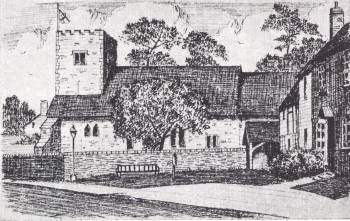![]()

![]()
28. St James-Without-the-Priory-Gate, Southwick

The history of this ancient church, the oldest part of which dates back to 1040, is closely connected with the priory founded by Henry I at Portchester in 1133. It was relocated 20 years later close to the church at Southwick. At the Dissolution of the Monasteries in 1538 Henry VIII sold the monastic estates to John Whyte and he was granted the office of Lay Prior. To this day the Master of Southwick holds this office and the church is known as the Lay Peculiar of Southwick being exempt from diocesan jurisdiction.
Enter by the West Door, under the tower and the 17th century panelled gallery with its supporting moulded posts, and the eye is caught by the blue painted barrel ceiling of the nave. To the right is the impressive three decker pulpit of 1605 and behind it a large box pew originally for the ladies of Southwick House with the Squire's Pew opposite on the north side. Both are de luxe versions immaculately padded with blue cloth. Until 1955 the nave was full of boxed pews but these have been replaced by modern pews made by the estate workers.
The beautiful black altar table is Elizabethan and behind is a large reredos containing an 18th century painting of a dove and cherubs by an Italian artist. The altar rails are Jacobean as are the massive brass altar candlesticks presented by Richard Norton, Master of Southwick in the early 17th century. High on the south side of the Sanctuary are three plaques. One shows a Saracens Head, one the Norton Arms and the third a Golden Lion.
The north side of the chancel is dominated by the large tomb chest of John Whyte the first Lay Prior who died in 1567. On it are brasses of himself, his wife and their children. Above is a canopy with heraldic shields and family crests. The north panel is very weathered and it seems likely that the tomb once stood in the Priory grounds.
On the south side of the chancel are numerous monuments to the Thistlethwayte and Borthwick Norton families, the most recent being that of Eva Borthwick-Norton, Squire of Southwick until 1988. Two older memorials are worth noting. High up near the ceiling is the memorial of Arthur Henry Thistlethwayte of the Scots Fusilier Guards who served in the Crimean War. He was at Alma, 'the terrible battle of Inkerman' and later 'succumbed to fatigue and dysentery and fever' during the siege of Sebastopol. He died at Scutari Hospital in November 1854 aged 23. Perhaps he was nursed by Florence Nightingale?
Another very sad memorial is a perfect illustration of the sacrifices and losses sustained by military families whilst serving in the Empire. It records the deaths of the 4 sons of Lt.General Sir Hercules Pakenham. Edward William was killed at Inkerman in 1854, Robert Max was killed during the Siege of Lucknow in 1857, Edmund Powerscourt died at Fort Gwalior in 1861 and finally Charles Wellesley died "of decline" on the Hydaspes in 1877.
In the north west corner of the church is a large lead lined octagonal font for the dipping of infants. On the North Wall is the very fine village War Memorial in brass flanked by 4 flags, the White Ensign, the Red Ensign, the Union Jack and the RAF flag. Alongside are a number of other memorials to servicemen killed since 1945. Further along, past the modern organ, is a brass plaque in the North Aisle chapel. It says, 'Pray for the soul of Anne Whyte wife of John Whyte of Southwick' and is dated 1577.
On the gallery at the west end a board commemorates two benefactors of the church who left money for the poor of the parish. Mrs Honor Wayte, in her will of March 1559 left 20 shillings a year whilst John Soaper a surgeon left the interest on £400 in 1834. Before leaving note the 2 brass chandeliers each holding 8 candles which are still lit on special occasions and also, high on the south wall the funeral hatchment of Mary Ann Thistlethwayte who died in 1821.
Outside in the churchyard a huge slab of stone on the south side covers the entrance to the Thistlethwayte vault. On the East wall of the church is a tablet commemorating the grant to John Whyte in 1539 and not far away is the tombstone of a poacher William Lewis who died aged 80 in 1763. It has a bizarre inscription.
'Here low is the brave
That neer was a slave
To Norton the
Great
Drove him to Fate.
He returns home to Reft
Like Norton the
Great
O men would be Gods.'
One final historical episode should be recorded. In 1628 King Charles I was worshipping in the church as guest of the squire Sir Daniel Norton, when he received the startling news of the assassination of the Duke of Buckingham in Portsmouth. Ironically Sir Daniel's heir, Colonel Richard Norton, later became a Cromwellian and signed the death warrant of the King in 1649.
Click here to go to the website for St James, Southwick
written by John Symonds
![]() Return to the May 1999 Features page
Return to the May 1999 Features page
![]() return to Home page and main index
return to Home page and main index
page last updated 1 JANUARY 2011